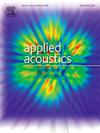双频超声控制声空化产率:李雅普诺夫指数分析
IF 3.4
2区 物理与天体物理
Q1 ACOUSTICS
引用次数: 0
摘要
由Rayleigh-Plesset方程描述的气泡半径显示了一个完全非线性的结构,并在参数值范围内表现出混沌行为。在本文中,我们首先展示了气泡在不同系统参数下的混沌振荡,包括频率、振幅、粘度和表面张力。随后,我们通过数值分析和模拟,利用周期摄动方法调节气泡的混沌动力学。控制参数的适当值是根据先前的实验室结果通过分岔图验证确定的。采用两种模拟技术,即分岔图和李雅普诺夫指数(LE)的数值计算,对所提出的方法进行了评估。本文首次对声空化控制器的参数进行了解析计算,并验证了其控制效果。研究结果表明,该方法可以显著减少并潜在地消除系统湍流。用超声波对铝箔的破坏面积和次谐波的测量两种方法对该方法的准确性进行了实验研究,表明了该方法的有效性。本文章由计算机程序翻译,如有差异,请以英文原文为准。
Control of acoustic cavitation yield by dual frequency sonication: A Lyapunov exponent analysis
The radius of a bubble, described by the Rayleigh-Plesset equation, demonstrates a completely nonlinear structure and exhibits chaotic behavior across a range of parameter values. In this paper, we first present the chaotic oscillations of a bubble subjected to varying system parameters, including frequency, amplitude, viscosity, and surface tension. Subsequently, we utilize the periodic perturbation method to regulate the bubble’s chaotic dynamics through numerical analysis and simulation. The appropriate values for the control parameters were determined based on previous laboratory results validated by bifurcation diagram. The proposed method has been evaluated using two simulation techniques, namely, bifurcation diagrams and numerical calculations of the Lyapunov exponent (LE). This study represents the first instance where the parameters of the acoustic cavitation controller are analytically calculated, and their effects have been confirmed. The findings indicate that the proposed method can significantly reduce and potentially eliminate system turbulence. The accuracy of the proposed method has been also investigated experimentally using two approaches: the area of aluminum foil destruction by ultrasound waves and the measurement of subharmonics which indicates the effectiveness of the proposed method.
求助全文
通过发布文献求助,成功后即可免费获取论文全文。
去求助
来源期刊

Applied Acoustics
物理-声学
CiteScore
7.40
自引率
11.80%
发文量
618
审稿时长
7.5 months
期刊介绍:
Since its launch in 1968, Applied Acoustics has been publishing high quality research papers providing state-of-the-art coverage of research findings for engineers and scientists involved in applications of acoustics in the widest sense.
Applied Acoustics looks not only at recent developments in the understanding of acoustics but also at ways of exploiting that understanding. The Journal aims to encourage the exchange of practical experience through publication and in so doing creates a fund of technological information that can be used for solving related problems. The presentation of information in graphical or tabular form is especially encouraged. If a report of a mathematical development is a necessary part of a paper it is important to ensure that it is there only as an integral part of a practical solution to a problem and is supported by data. Applied Acoustics encourages the exchange of practical experience in the following ways: • Complete Papers • Short Technical Notes • Review Articles; and thereby provides a wealth of technological information that can be used to solve related problems.
Manuscripts that address all fields of applications of acoustics ranging from medicine and NDT to the environment and buildings are welcome.
 求助内容:
求助内容: 应助结果提醒方式:
应助结果提醒方式:


